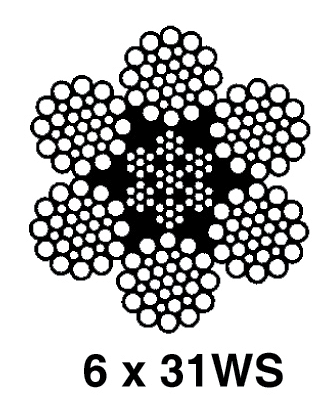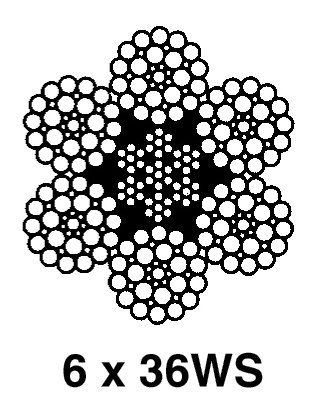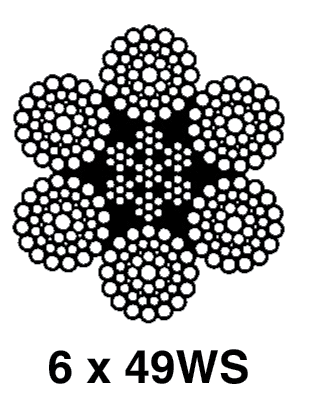Standard 6×19 and 6×36 Classifications of Wire Rope
While the 6x19 ropes give primary emphasis to abrasion resistance in varying degrees, the 6x36 ropes are important for their fatigue resistance.
The 6 x 19 classification of wire rope includes standard 6 strand, round strand ropes with 16 through 26 wires per strand.
The 6 x 36 classification of wire rope includes standard 6 strand, round strand ropes with 27 through 49 wires per strand.
Although their operating characteristics vary, all have the same weight per foot and the same minimum breaking force, size for size.
While the 6 x 19 ropes give primary emphasis to abrasion resistance in varying degrees, the 6 x 36 ropes are important for their fatigue resistance. This fatigue resistance is made possible by the greater number of small wires per strand.
Although there are exceptions for special applications, the constructions in 6 x 36 classification are primarily designed to be the most efficient for each rope diameter. As the rope size increases, for instance, a large number of wires can be used to achieve required fatigue resistance, and still those wires will be large enough to offer adequate resistance to abrasion.
6 x 19 Classification of Wire Ropes— 6 x 19S (Seale)
In this construction, each strand has nine outer wires over nine smaller inner wires over one large center wire. A comparison of cross sections shows that these outside wires are larger than those of 6 x 25FW or 6 x 26WS. Therefore, its resistance to abrasion is increased, but its fatigue resistance is decreased. This is a rope to withstand abrasion or crushing on the drum.

6 x 25FW (Filler Wire)
To most wire rope users, 6 x 19 means 6 x 25 filler wire. It was the most common rope in the 6 x 19 classification. This rope has a good balance between both abrasion resistance and fatigue resistance in relation to other ropes.

6 x 26WS (Warrington Seale)
This construction has better resistance to abrasion than a 6 x 25FW. It also features a compact construction with solid support for the wires. Hence, it has high resistance to crushing. Its number and relative size of the inner wires add to the stability of the strand and gives a fatigue resistance comparable to a 6 x 25FW. A standard 6 x 26WS construction the best rope for a wide range of applications. In general, we recommend the use of a 6 x 26WS in any application where a 6 x 25FW is used.

6 x 36 Classification of Wire Ropes
In most rope sizes, only one 6 x 36 classification rope is made. These constructions were selected to provide fatigue resistance without having wires that are too small. The greater number of wires in the 6 x 36 classification makes these ropes more susceptible to crushing. This can be minimized, however, by specifying an independent wire rope core (IWRC) and by using well-designed sheaves, grooved drums and proper operating techniques.





